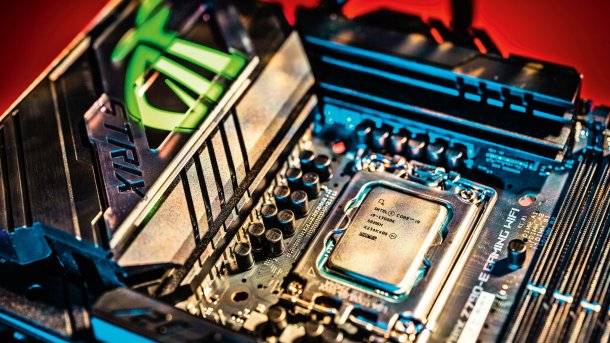Crashes: Asus stabilizes Intel processors with BIOS updates
Mainboard manufacturers are apparently overdoing it with the factory settings. A basic profile should now increase the stability of Asus models.

(Bild: c't)
Asus is the first motherboard manufacturer to respond to the numerous reports of unstable Intel processors in the Core i-13000 and Core i-14000 series, particularly in the Core i9 models. BIOS updates for all Z790 mainboards introduce an "Intel Baseline Profile", which allows Intel processors to run in accordance with specifications. Z690 models have not yet received such updates.
The new settings are intended to prevent stability-related crashes caused by leveraged limits, including the maximum permissible electrical power consumption (power limit) and the permissible voltages and currents. The Core i9-14900KS, for example, then runs with a maximum of 253 watts and not unlimited at well over 300 watts. The voltages and currents are also more strictly limited.
Problems in games and applications
The problematic BIOS settings are set ex works by all mainboard manufacturers for most models. Intel has tolerated this practice so far. However, this can lead to problems, especially with the latest Core i9 processors, because Intel is already pushing these models close to their clock limits with Turbo modes of around 6 GHz.
Many reports refer to games with Unreal Engine 5, such as "Fortnite". They display error messages stating that too little graphics memory is available. In reality, however, CPU calculation errors are often to blame for the crashes.
We have also received emails from readers stating that stability-related errors also occur reproducibly in applications or when compiling code, for example. Intel is aware of the reports and, according to its previous statement, the company is investigating the issues – there is no further information from the official side.
Five adjustments in the BIOS
Asus' "Intel Baseline Profile" makes five changes to the BIOS according to the X-Account "9550pro": Primarily, it disables Multi-Core Enhancement, a factory overclocking option, and sets the SVID behavior to a fail-safe mode. SVID stands for Serial Voltage Identification Debug (Protocol) and affects the CPU core voltages.
In addition, the Thermal Design Current (TDC) limit is set according to Intel's specifications. Asus activates two options for Current Excursion Protection (CEP) with the profile. They are intended to prevent calculation errors caused by excessively low voltages in the CPU cores (IA CEP) and the remaining logic blocks (SA CEP).
Empfohlener redaktioneller Inhalt
Mit Ihrer Zustimmmung wird hier ein externer Preisvergleich (heise Preisvergleich) geladen.
Ich bin damit einverstanden, dass mir externe Inhalte angezeigt werden. Damit können personenbezogene Daten an Drittplattformen (heise Preisvergleich) übermittelt werden. Mehr dazu in unserer Datenschutzerklärung.
(mma)